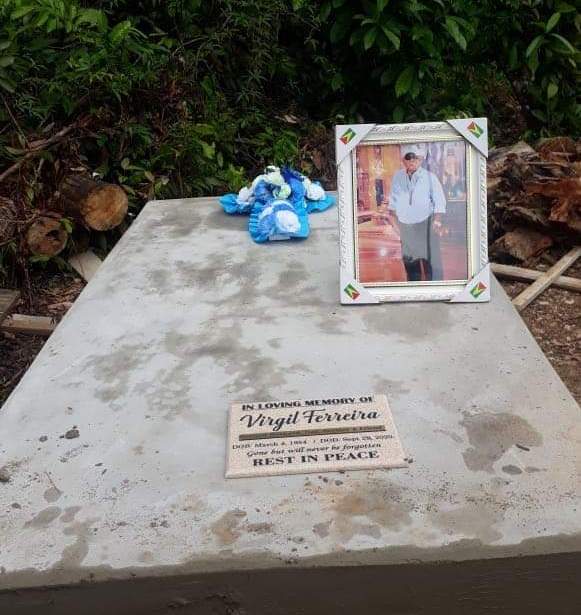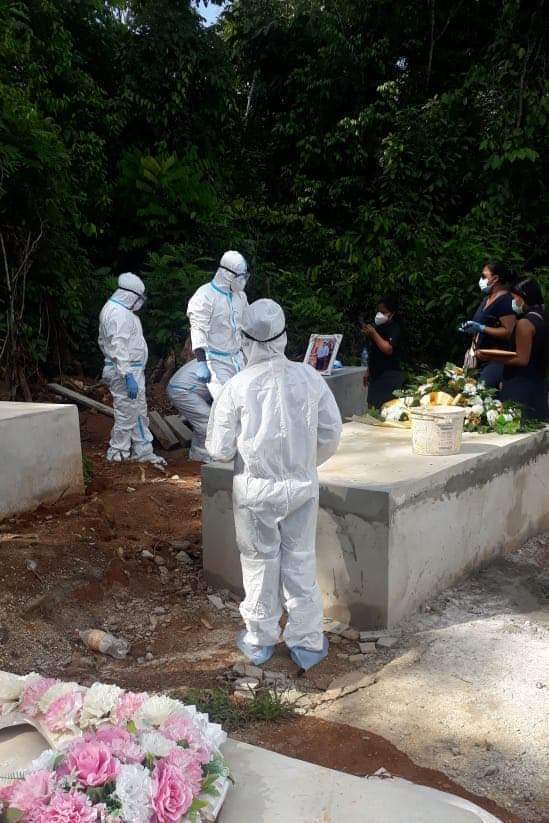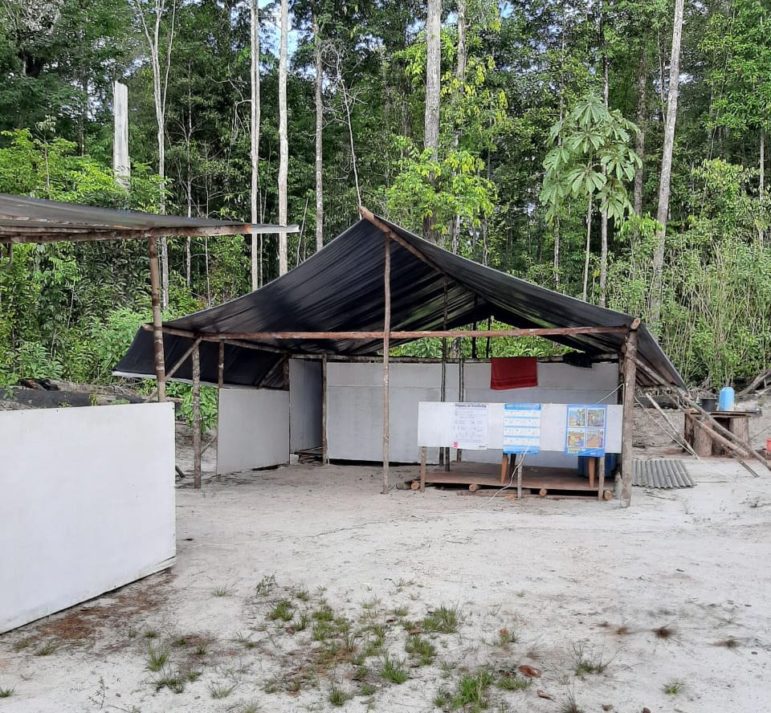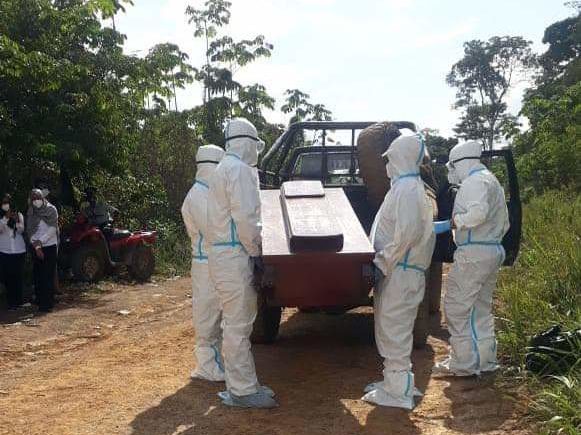The lonesome death of Virgil Ferreira occurred on September 29, 2020, not long after the 64-year-old diabetic began experiencing shortness of breath, a persistent cough and loss of taste and smell, all symptoms of the COVID-19 virus.
After Ferreira fell ill, he was taken to the health center in Baramita, a village in the dense Guyanese jungle. Within days, Ferreira’s condition worsened. Health authorities transferred him to the nearest regional hospital in Port Kaituma, where he died two weeks later.
Ferreira left behind a wife and several school-aged children as well as 9 elder children from previous unions.

“They took his remains straight from the mortuary at Port Kaituma to the cemetery in Baramita, no lingering, no service nothing,” said a friend and former colleague, who was familiar with the man’s last moments.
Only a handful of people were present at Ferreira’s burial. His wife and one of his youngest sons, whose names were not provided, had to seek permission from the health authorities to be at the funeral. They were placed in quarantine right after the funeral.
Before his death, Ferreira worked as a community development officer at the Carib-speaking village of Baramita. He moved there, with the blessings of his employer, the Ministry of Amerindian Affairs. Colleagues described how he was passionate about indigenous rights and how he worked tirelessly with villagers to fight many ills afflicting the community, including a high suicide rate, alcoholism and domestic abuse.
“You did your best for Baramita,” said Sharmain Rambajue, the so-called toshao or village captain of Baramita in a tribute to Ferreira. “I have learned a lot from you during the time we worked together for my beloved community.”
Ferreira’s death shocked many of his colleagues and friends, including people in his hometown of Moruca, where he is revered for championing indigenous rights.

People in indigenous communities across Guyana are increasingly bearing the brunt of the coronavirus toll. Many of them are now having to cope with the news that their loved ones are being buried dozens of miles away from home under strict COVID guidelines.
In late October, Guyana had recorded 123 deaths from 4,078 positive cases of COVID-19. Some 3083 people have recovered.
In recent weeks, coronavirus cases have skyrocketed, with more than 70 deaths recorded between August and mid-October 2020. Some 22 deaths were recorded between March and July.
Ferreira was the latest casualty from the North West District region of Guyana, one of the areas within the country hardest hit by the pandemic– since the first case was recorded here in April 2020.
Although a high rate of positive cases were being recorded, the fatality rate remained low. That changed drastically during the months of September and October, when more than 20 people in the region, mainly elderly patients above age 50, died within days of each other from COVID-19 complications.
Health Minister Dr. Frank Anthony attributed the spike in deaths in Guyana to underlying conditions such as diabetes, hypertension, cardiovascular diseases and cancers. He has stated in local media reports that if the results of mass screening of particularly elderly patients and awareness campaigns in the North West District, prove successful, these exercises would be reciprocated across the country.
In September, Anthony, who assumed his current portfolio in August this year when a new government was sworn in, said a lack of mobile phone communication in hinterland areas had hampered the government’s response to affected communities. Among measures implemented by the authorities were travel bans to communities in the hinterlands. In recent weeks, such bans have been lifted.
A Place Where People Farm, Fish and Search for Gold
The North West District, also known as Region One, is Guyana’s northern-most administrative region.
It is divided into three sub-regions; Mabaruma, the most northerly, followed by the Matarkai and Moruca, the most southerly.
Mabaruma is also the seat of governance for the region and is its only town.
Within the region, farming, logging and fishing are the main economic activities. Gold mining has become the main economic activity within the Matarkai sub-region, mainly at the rough, hilly terrain near the community of Port Kaituma, where mining activities have been ongoing for decades.
Moruca, home of Guyana’s most populated indigenous village, Santa Rosa, is the nearest to the capital of Georgetown in terms of accessibility. People travel to and from this area daily by water and road, with the initial stop off point at Charity on the Pomeroon River being the first port of entry from Moruca.
From there, buses and cars take travelers south along the Essequibo Coast to the port of Supenaam where they board a daily-operated, government ferry. Water taxis operate further south to the port of Parika. From here, private road transportation is available almost around the clock to take travelers to Georgetown along the West Coast of Demerara.
CIJN writers visited some of the areas at the periphery of the Moruca sub-region, where travel bans were lifted during the month of August.
How the Villages are Coping
Jannry Francis , a mother of six, lives at the remote village of Kwebanna, located within the Moruca sub-region. That sub-region is considered a COVID-19 hotspot in Guyana’s hinterland where approximately 237 cases were recorded between since May 2020. Since the three sub-regions -Moruca, Matarkai and Mabaruma- are connected by rivers, transmission of the virus was inevitable.

Kwebanna’s Stringent Measures
Francis said the villagers at Kwebanna are worried about the situation and while COVID-19 has led to economic disruptions in community life, residents are trying their best to follow health precautions and maintain awareness among fellow villagers.
“People cannot go in as they like,” Francis said of access to her village, which, like Baramita, is one of a few remaining Carib-speaking villages in Guyana.
Since the CIJN’s interview with Francis, the situation changed drastically at Kwebanna, which has become the epicenter of COVID-19 cases in the North West District.
Kwebanna has seen an upsurge in cases since mid-October, with more than 53 cases recorded there while two elderly people from the village died from complications relating to COVID-19 .
After the health minister health told the local media that coronavirus cases were unusually high at Kwebanna, a special health team along with police and army personnel was rushed to the remote village. Police and soldiers were ordered to enforce a lockdown of the district, which took effect on October 25.
Before the village lockdown, the Kwebanna Village Council gave permission for people to enter and leave the village, Francis said. Mondays and Fridays were the only designated days when people can travel to or leave the village unless special permission is granted for travel.
What alarmed many, including indigenous activists who were raised at the Moruca sub-region, is that dozens of cases were recorded at Santa Rosa, the central hub of the sub-region within a three month period between May and August 2020.
Santa Rosa, the largest indigenous village in Guyana, is connected to Kwebanna and several other satellite villages by road and also by river. When the first case was recorded there late in May 2020, it created panic because the area is easily accessible by boat from the busy port at Charity on the Pomeroon shore in Guyana’s Region Two. Travel to and from Moruca was suspended in June this year and one of the critical economic links affected by the lockdown measures involved boat transportation services.
Boats Connect The Villages
Since the communities here are located along rivers, boat transportation services are an essential mode of travel. Cargo boats, passenger boats as well as small ships ferrying coconuts and other bulk supplies, are an everyday sight at Charity. Passenger boats dominate the scene ,especially on Mondays, the designated market day at Charity.
On market day, boat operators from Moruca rake in most of their profits, as the boats often travel at full capacity. Most passengers leave the sub-region for Charity to purchase goods for their households while others ferry cargo, such as supplies for their shops and small businesses.
How The Boatmen Were Affected
“The cases ease up now but you still got to wear your mask, maintain social distance,” said Troy Abrahams, one of several boat captains who operate passenger boats almost daily between Charity and Moruca.
Abrahams said that when coronavirus cases were first recorded in May, the village was placed on lockdown for about two months. “We had to be home, I actually prepared for it , we had to make sure we had food stuff at home, one or two days we had to work,’ he said.
He said he operated his boat twice weekly during the lockdown between Moruca and Charity since his boss had a contract to ferry goods between the two locations. He said he could not carry passengers to Moruca in keeping with the laws in force. He said he followed the rules but some boat captains did not.
The Situation at Santa Rosa
Abrahams is from Santa Rosa and according to him, the village was the scene similar to a ghost town when the cases were being frequently recorded from May to June.
Abrahams said that when Guyana recorded its first case back in March 2020, an uneasy feeling overcame him. “I start trembling, I feel that fright , it shake me up you know,’ he said.
He noted that he immediately hurried to a supermarket at Charity to buy health supplies to protect himself and his family from the virus.
He said that for an entire week he was afraid to travel after Moruca recorded its first death.
Santa Rosa resident, Vincent Torres, 59, a former school teacher died on May 25 from COVID-19 complications and was listed as the eleventh coronavirus victim in Guyana and the first for the North West District region. Abrahams said he was shaken by Torres’ death. He and his family stayed indoors as fears spread through the community.
Doubts About Covid-19
Abrahams said that some people at Moruca doubted that the virus existed. He said he recently cautioned one doubter. “The next day I see the same man wearing a mask,” he chuckled.
Another boat operator, Johnny Henry, tested positive for COVID-19 in June 2020, but he continued to question about whether he had the virus. He is one of dozens of indigenous persons across Guyana who doubt the existence of COVID-19. It is a prevalent scenario encountered by health professionals who travel to the remote indigenous villages to test people for the virus.
Henry told CIJN that he believes he contracted malaria, noting that in the days prior to his COVID-19 diagnosis, he was hired to transport goods to a mining area in the North West region and soon after, he fell ill.
He said he stayed at a guesthouse in the area but he slept without a mosquito net, noting that mosquitoes are prevalent there. He said he was at home a week later when he started experiencing a fever and chills about his body.
Henry said he had a COVID-19 test, and received a phone call days later. His test was positive.
Henry said when he was placed in lockdown, it was one of the worst he experiences he had ever encountered. He was placed alone in a guest house at Santa Rosa. He could not receive food as frequently as he wanted. As the cases piled up, other people who tested positive were placed in the same room with him and, according to him, it became unbearable, He left the guesthouse without authorities’ permission.
Henry said his wife also tested positive for COVID-19 but, according to him, she experienced no symptoms.
The Situation in Other Interior Districts
The Rupununi region, located close to the Brazilian border, has experienced a drop in COVID-19 cases in recent weeks, although cases in some indigenous villages are still being recorded. To date, 362 cases have been recorded in the area, with a majority occurring at villages close to the border.
The villages of Baitoon, Potarinau and Quakko are among those which have seen a high number of cases, but there are other inland areas which have recorded imported cases from Georgetown.
One such area is Annai, home of predominantly members of the Wapishana and Makushi tribes. Virgil Harding, the chair of the Aranaputa/Upper Burro Burro Neighbourhood Democratic Council near Annai told CIJN that authorities were trying their slow the spread of the cases there.
“In our village we had 12 cases,” he said of Aranaputa. He said all 12 people tested recovered.
He said a permanent medical task force, comprising of two doctors, police officials and environmentalists, was stationed in the area. Authorities have been revisiting the patients who tested positive to carry out further tests, noting that some persons were in quarantine at their homes.
Although the Rupununi region is situated close to Brazil, which has recorded over 4.9 million cases of COVID-19, less than five deaths were officially recorded by the authorities here in Guyana.
Guyana’s Gold Mines and their Cover Clusters
Further north, the Cuyuni/Mazaruni region, another Hinterland area, has also recorded a high number of cases. Offically, some 303 cases have been recorded and most of the cases were recorded at the border villages near Brazil and Venezuela where miners have been travelling across the porous border almost daily to shop for goods and fuel.
The indigenous village of Batavia, located inland within the region, recorded more than a dozen cases thus far but the village council has enforced strict rules to stem the spread of the pandemic. Miners traveling back to Batavia from the border region are seen as the prime transmitters of the cases.
